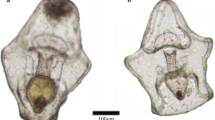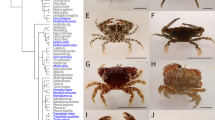Abstract
Coral-eating crown-of-thorns starfish (Acanthaster sp.) often exhibit dramatic population outbreaks, suggesting that their local abundance may be relatively unchecked by predators. This may be due to high concentrations of anti-predator chemicals (saponins and plancitoxins), but the effectiveness of chemical deterrents in protecting Acanthaster sp., especially spawned eggs, from predation remains controversial. We show that planktivorous damselfishes will readily consume food pellets with low proportions (≤80%) of eggs of crown-of-thorns starfish. However, all fishes exhibited increasing rejection of food pellets with higher proportions of starfish eggs, suggesting that chemicals in eggs of crown-of-thorns starfish do deter potential predators. Interestingly, palatability thresholds varied greatly among the nine species of planktivorous fish tested. Most notably, Amblyglyphidodon curacao consumed food pellets comprising 100% starfish eggs 1.5 times more than any other fish species, and appeared largely insensitive to increases in the concentration of starfish eggs. After standardising for size, smaller fish species consumed a disproportionate amount of pellets comprising high proportions of starfish eggs, indicating that abundant small-bodied fishes could be particularly important in regulating larval abundance and settlement success of crown-of-thorns starfish. Collectively, this study shows that reef fishes vary in their tolerance to anti-predator chemicals in crown-of-thorns starfish and may represent important predators on early life-history stages.



Similar content being viewed by others

References
Anderson M, Gorley RN, Clarke RK (2008) PERMANOVA + for PRIMER: Guide to software and statistical methods. PRIMER-E, Plymouth
Babcock RC, Bull GD, Harrison PL, Heyward AJ, Oliver JK, Wallace CC, Willis BL (1986) Synchronous spawnings of 105 scleractinian coral species on the Great Barrier Reef. Mar Biol 90:379–394
Bachiller E, Cotano U, Ibaibarriaga L, Santos M, Irigoien X (2015) Intraguild predation between small pelagic fish in the Bay of Biscay: impact on anchovy (Engraulis encrasicolus L.) egg mortality. Mar Biol 162:1351–1369
Bailey KM, Houde ED (1989) Predation on eggs and larvae of marine fishes and the recruitment problem. Adv Mar Biol 25:1–83
Baird AH, Pratchett MS, Gibson DJ, Koziumi N, Marquis CP (2001) Variable palatability of coral eggs to a planktivorous fish. Mar Freshw Res 52:865–868
Barnett D, Dean PW, Hart RJ, Lucas JS, Salathe R, Howden MEH (1988) Determination of contents of steroidal saponins in starfish tissues and study of their biosynthesis. Comp Biochem Physiol B 90:141–145
Birkeland CE, Lucas JS (1990) Acanthaster planci: major management problem of coral reefs. CRC Press, Boca Raton, FL
Branham JM (1973) The crown of thorns on coral reefs. BioScience 23:219–226
Caballes CF, Pratchett MS, Kerr AM, Rivera-Posada JA (2016) The role of maternal nutrition on oocyte size and quality, with respect to early larval development in the coral-eating starfish. Acanthaster planci. PLoS One 11:e0158007
Campbell AC, Ormond RFG (1970) The threat of ‘crown-of-thorns’ starfish (Acanthaster planci) to coral reefs in the Indo-Pacific area: observations on a normal population in the Red Sea. Biol Conserv 2:246–251
Ciarapica G, Passeri L (1993) An overview of the Maldivian coral reefs in Felidu and North Male atoll (Indian Ocean): platform drowning by ecological crises. Facies 28:33–65
Conand C (1984) Distribution, reproductive cycle and morphometric relationships of Acanthaster planci (Echinodermata: Asteroidea) in New Caledonia, western tropical Pacific. Proceedings of the 5th International Echinoderm Conference, Galway, Ireland, pp 499–506
Cowan Z-L, Dworjanyn SA, Caballes CF, Pratchett MS (2016) Predation on crown-of-thorns starfish larvae by damselfishes. Coral Reefs 35:1253–1262
Dulvy NK, Freckleton RP, Polunin NV (2004) Coral reef cascades and the indirect effects of predator removal by exploitation. Ecol Lett 7:410–416
Endean R (1969) Report on investigations made into aspects of the current Acanthaster planci (crown of thorns) infestations of certain reefs of the Great Barrier Reef. Queensland Department of Primary Industries (Fisheries Branch), Brisbane, Australia
Endean R (1977) Acanthaster planci infestations of reefs of the Great Barrier Reef. Proc 6th Int Coral Reef Symp 1:185–191
Gladstone W (1992) Observations of crown-of-thorns starfish spawning. Aust J Mar Freshw Res 43:535–537
Hamner WM, Jones MS, Carleton JH, Hauri IR, Williams DM (1988) Zooplankton, planktivorous fish, and water currents on a windward reef face: Great Barrier Reef, Australia. Bull Mar Sci 42:459–479
Hixon MA, Pacala SW, Sandin SA (2002) Population regulation: historical context and contemporary challenges of open vs. closed systems. Ecology 83:1490–1508
Hixon MA, Anderson TW, Buch KL, Johnson DW, McLeod JB, Stallings CD (2012) Density dependence and population regulation in marine fish: a large-scale, long-term field manipulation. Ecol Monogr 82:467–489
Kamya PZ, Dworjanyn SA, Hardy N, Mos BJ, Uthicke S, Byrne M (2014) Larvae of the coral eating crown-of-thorns starfish, Acanthaster planci in a warmer-high CO2 ocean. Glob Chang Biol 20:3365–3376
Keesing JK, Halford AR (1992) Importance of postsettlement processes for the population dynamics of Acanthaster planci (L.). Aust J Mar Freshw Res 43:635–651
Komyakova V, Munday PL, Jones GP (2013) Relative importance of coral cover, habitat complexity and diversity in determining the structure of reef fish communities. PLoS One 8:e83178
Leis JM (1991) The pelagic phase of coral reef fishes: larval biology of coral reef fishes. In: Sale PF (ed) Coral reef fishes: dynamics and diversity in a complex ecosystem. Academic Press, San Diego, CA, pp 183–230
Lindquist N (1996) Palatability of invertebrate larvae to corals and sea anemones. Mar Biol 126:745–755
Lindquist N, Hay ME (1996) Palatability and chemical defense of marine invertebrate larvae. Ecol Monogr 66:431–450
Lucas JS (1975) Environmental influences on the early development of Acanthaster planci (L). Crown-of-thorns starfish seminar proceedings, Australian Government Publishing Service, Canberra, pp 109–121
Lucas JS, Hart RJ, Howden ME, Salathe R (1979) Saponins in eggs and larvae of Acanthaster planci (L.) (Asteroidea) as chemical defences against planktivorous fish. J Exp Mar Biol Ecol 40:155–165
Mackie AM, Singh HT, Owen JM (1977) Studies on the distribution, biosynthesis and function of steroidal saponins in echinoderms. Comp Biochem Physiol B 56:9–14
McCallum HI (1990) Effects of predation on Acanthaster: age-structured metapopulation models. In: Bradbury R (ed) Acanthaster and the coral reef: a theoretical perspective. Springer-Verlag, Berlin, Heidelberg, pp 208–219
McCallum HI (1992) Completing the circle: stock-recruitment relationships and Acanthaster. Mar Freshw Res 43:653–662
McCallum HI, Endean R, Cameron AM (1989) Sublethal damage to Acanthaster planci as an index of predation pressure. Mar Ecol Prog Ser 56:29–36
Morello EB, Plagányi ÉE, Babcock RC, Sweatman H, Hillary R, Punt AE (2014) Model to manage and reduce crown-of-thorns starfish outbreaks. Mar Ecol Prog Ser 512:167–183
Pearson RG, Endean R (1969) A preliminary study of the coral predator Acanthaster planci (L.) on the Great Barrier Reef. Fisheries Notes 3:27–55
Pratchett MS, Gust N, Goby G, Klanten SO (2001) Consumption of coral propagules represents a significant trophic link between corals and reef fish. Coral Reefs 20:13–17
Pratchett MS, Coker DF, Jones GP, Munday PL (2012) Specialization in habitat use by coral reef damselfishes and their susceptibility to habitat loss. Ecol Evol 2:2168–2180
Pratchett MS, Caballes CF, Rivera-Posada JA, Sweatman HPA (2014) Limits to understanding and managing outbreaks of crown-of-thorns starfish (Acanthaster sp.). Oceanogr Mar Biol Annu Rev 52:133–200
Rivera-Posada J, Caballes CF, Pratchett MS (2014) Size-related variation in arm damage frequency in the crown-of-thorns sea star, Acanthaster planci. Journal of Coastal Life Medicine 2:187–195
Sweatman HPA, Cheal AJ, Coleman GJ, Fitzpatrick BM, Miller IR, Ninio R, Osborne K, Page CM, Ryan DAJ, Thompson AA, Tomkins P (2000) Long-term monitoring of the Great Barrier Reef. Status report 4. Australian Institute of Marine Science, Townsville, p 117
Voogt PA, Van Rheenen JWA (1979) Studies on the possible regulatory function of astero-saponins in oocyte maturation and early embryogenesis of Asterias rubens. International Journal of Invertebrate Reproduction 1:307–316
Westneat MW, Resing JM (1988) Predation on coral spawn by planktivorous fish. Coral Reefs 7:89–92
Yamaguchi M (1973) Early life histories of coral reef asteroids, with special reference to Acanthaster planci (L.). In: Jones OA, Endean R (eds) Biology and geology of coral reefs, vol 2., BiologyAcademic Press, New York, pp 369–387
Yamaguchi M (1974) Larval life span of the coral reef asteroid Gomophia egyptiaca Gray. Micronesica 10:57–64
Yamaguchi M (1975) Coral-reef asteroids of Guam. Biotropica 7:12–23
Acknowledgements
This project was funded by an Ian Potter Foundation 50th Anniversary Commemorative Grant awarded to ZLC by the Australian Museum Lizard Island Research Station, in addition to a research allocation supplied by the ARC Centre of Excellence for Coral Reef Studies. We would like to thank Jordi Boada Garcia, Vanessa Messmer, Ben Mos and Molly Scott for field and laboratory assistance. Research was conducted in accordance with the James Cook University animal ethics guidelines. Fish were collected under Great Barrier Reef Marine Park Authority Permit Number G13/35909.1.
Author information
Authors and Affiliations
Corresponding author
Additional information
Communicated by Ecology Editor Dr. Alastair Harborne
Rights and permissions
About this article
Cite this article
Cowan, ZL., Ling, S.D., Dworjanyn, S.A. et al. Interspecific variation in potential importance of planktivorous damselfishes as predators of Acanthaster sp. eggs. Coral Reefs 36, 653–661 (2017). https://doi.org/10.1007/s00338-017-1556-y
Received:
Accepted:
Published:
Issue Date:
DOI: https://doi.org/10.1007/s00338-017-1556-y



